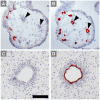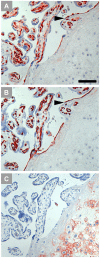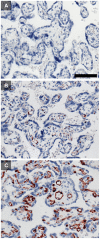Vascular endothelial expression of indoleamine 2,3-dioxygenase 1 forms a positive gradient towards the feto-maternal interface
- PMID: 21755000
- PMCID: PMC3130744
- DOI: 10.1371/journal.pone.0021774
Vascular endothelial expression of indoleamine 2,3-dioxygenase 1 forms a positive gradient towards the feto-maternal interface
Abstract
We describe the distribution of indoleamine 2,3-dioxygenase 1 (IDO1) in vascular endothelium of human first-trimester and term placenta. Expression of IDO1 protein on the fetal side of the interface extended from almost exclusively sub-trophoblastic capillaries in first-trimester placenta to a nearly general presence on villous vascular endothelia at term, including also most bigger vessels such as villous arteries and veins of stem villi and vessels of the chorionic plate. Umbilical cord vessels were generally negative for IDO1 protein. In the fetal part of the placenta positivity for IDO1 was restricted to vascular endothelium, which did not co-express HLA-DR. This finding paralleled detectability of IDO1 mRNA in first trimester and term tissue and a high increase in the kynurenine to tryptophan ratio in chorionic villous tissue from first trimester to term placenta. Endothelial cells isolated from the chorionic plate of term placenta expressed IDO1 mRNA in contrast to endothelial cells originating from human umbilical vein, iliac vein or aorta. In first trimester decidua we found endothelium of arteries rather than veins expressing IDO1, which was complementory to expression of HLA-DR. An estimation of IDO activity on the basis of the ratio of kynurenine and tryptophan in blood taken from vessels of the chorionic plate of term placenta indicated far higher values than those found in the peripheral blood of adults. Thus, a gradient of vascular endothelial IDO1 expression is present at both sides of the feto-maternal interface.
Conflict of interest statement
Figures











References
-
- Munn DH, Zhou M, Attwood JT, Bondarev I, Conway SJ, et al. Prevention of allogeneic fetal rejection by tryptophan catabolism [see comments]. Science. 1998;281:1191–1193. - PubMed
-
- Hönig A, Rieger L, Kapp M, Sutterlin M, Dietl J, et al. Indoleamine 2,3-dioxygenase (IDO) expression in invasive extravillous trophoblast supports role of the enzyme for materno-fetal tolerance. J Reprod Immunol. 2004;61:79–86. - PubMed
-
- Kudo Y, Boyd CA, Spyropoulou I, Redman CW, Takikawa O, et al. Indoleamine 2,3-dioxygenase: distribution and function in the developing human placenta. J Reprod Immunol. 2004;61:87–98. - PubMed
Publication types
MeSH terms
Substances
LinkOut - more resources
Full Text Sources
Other Literature Sources
Research Materials

